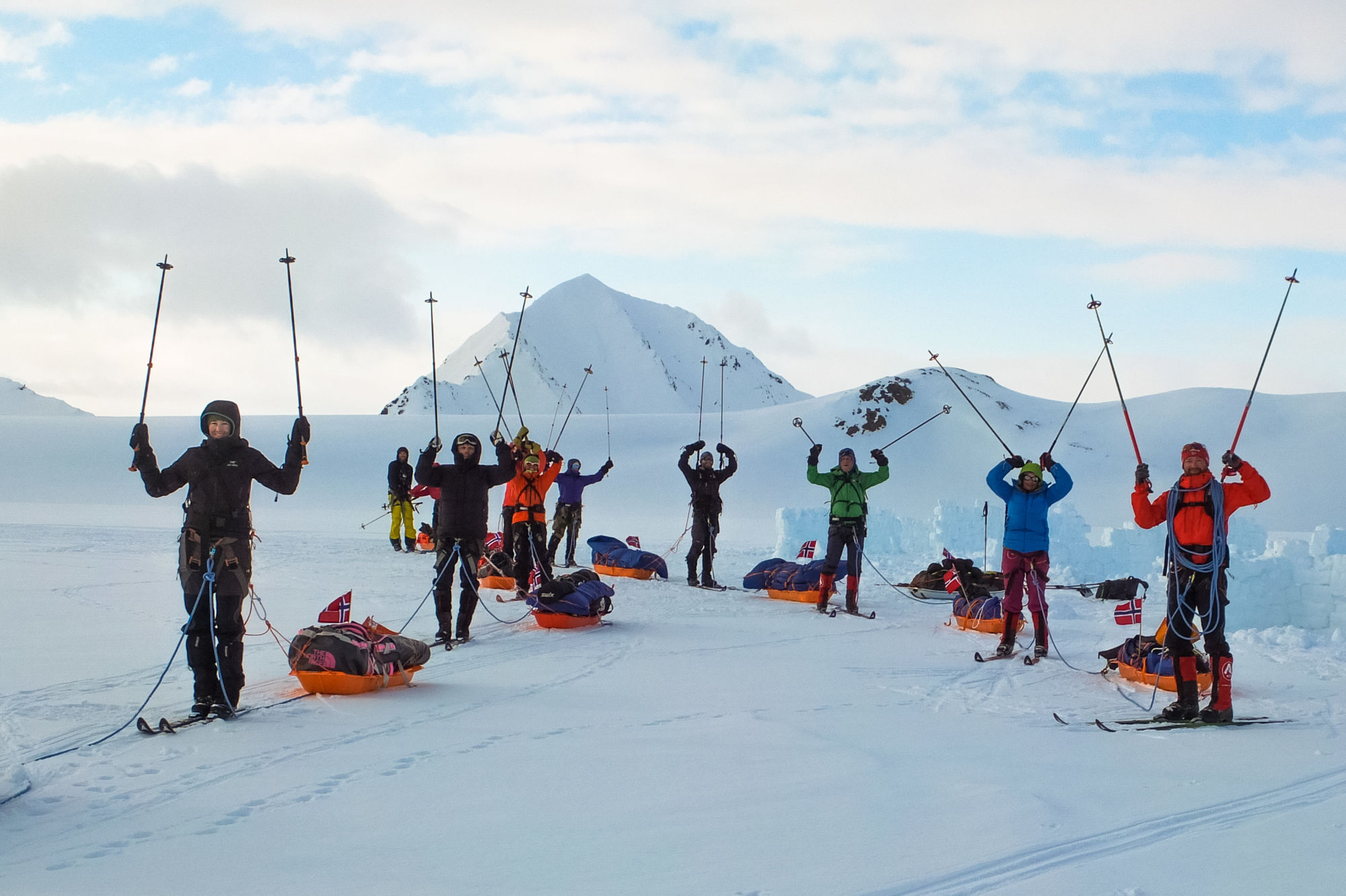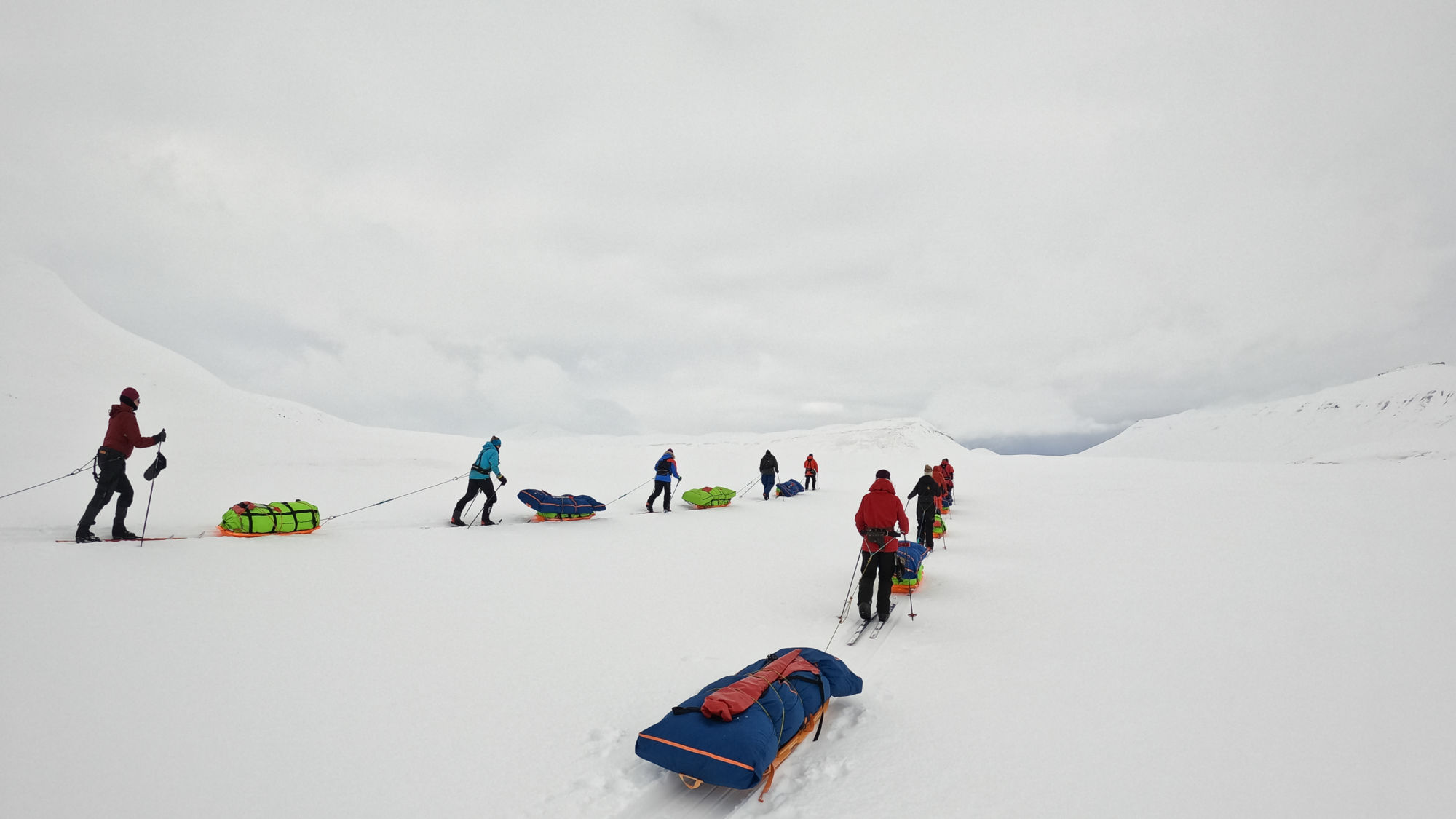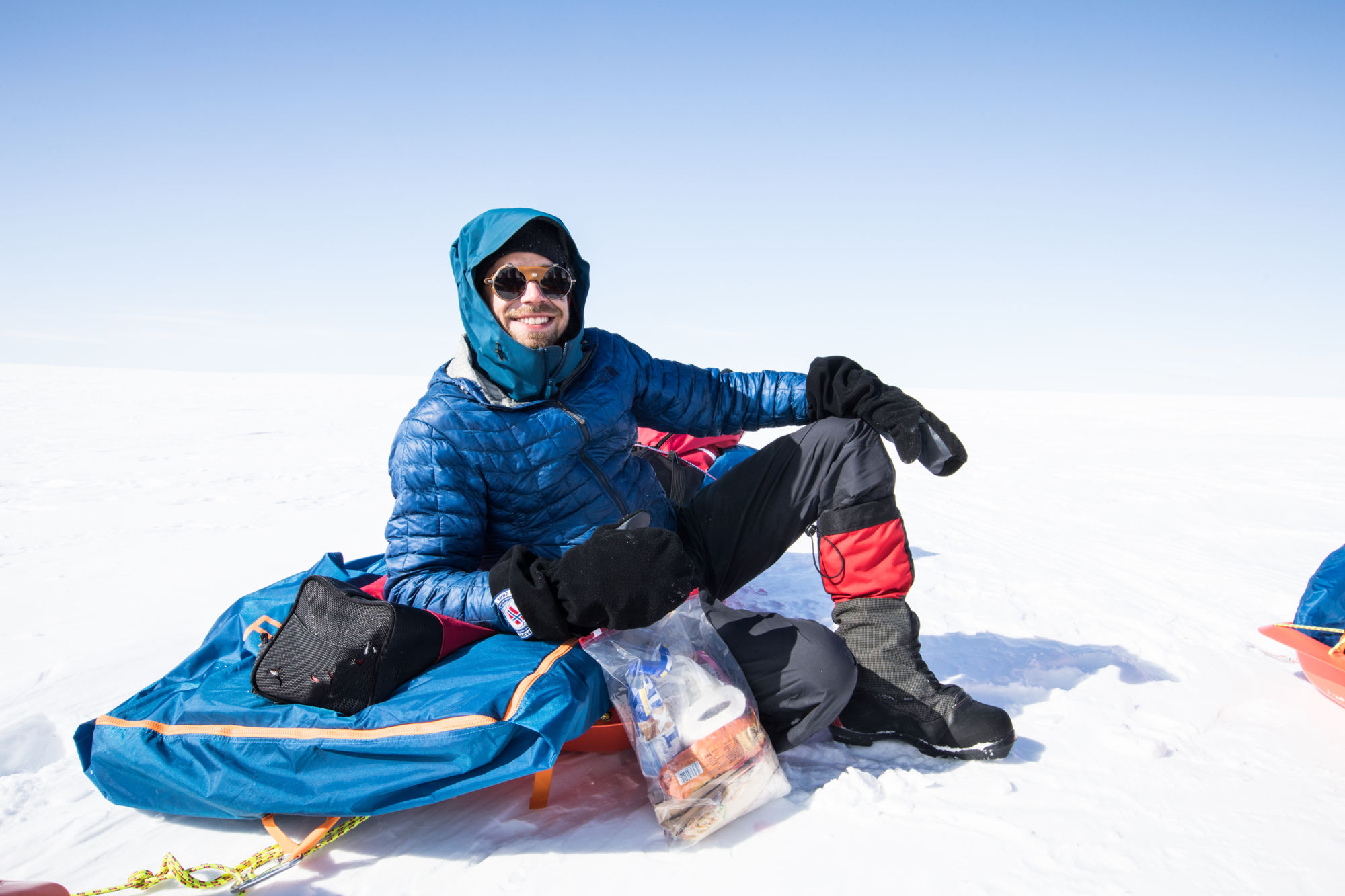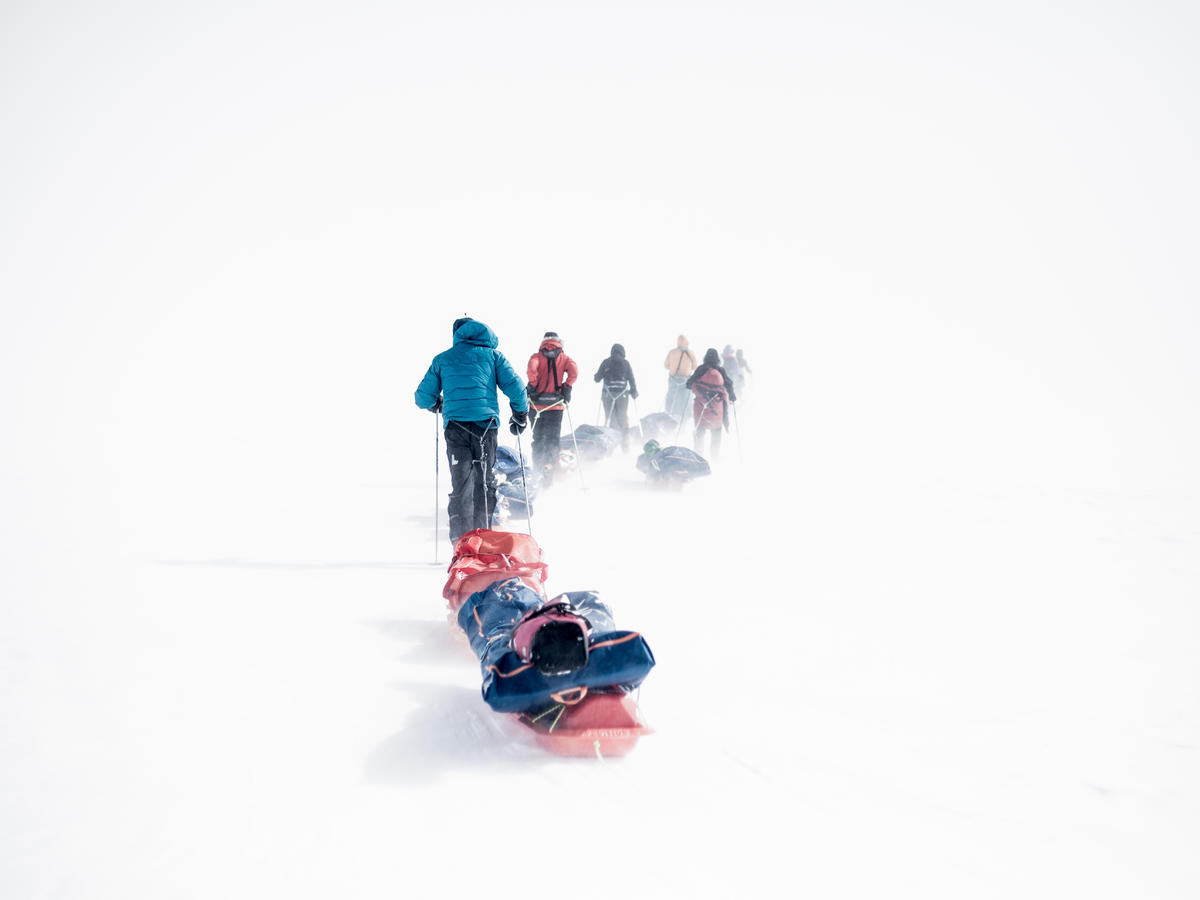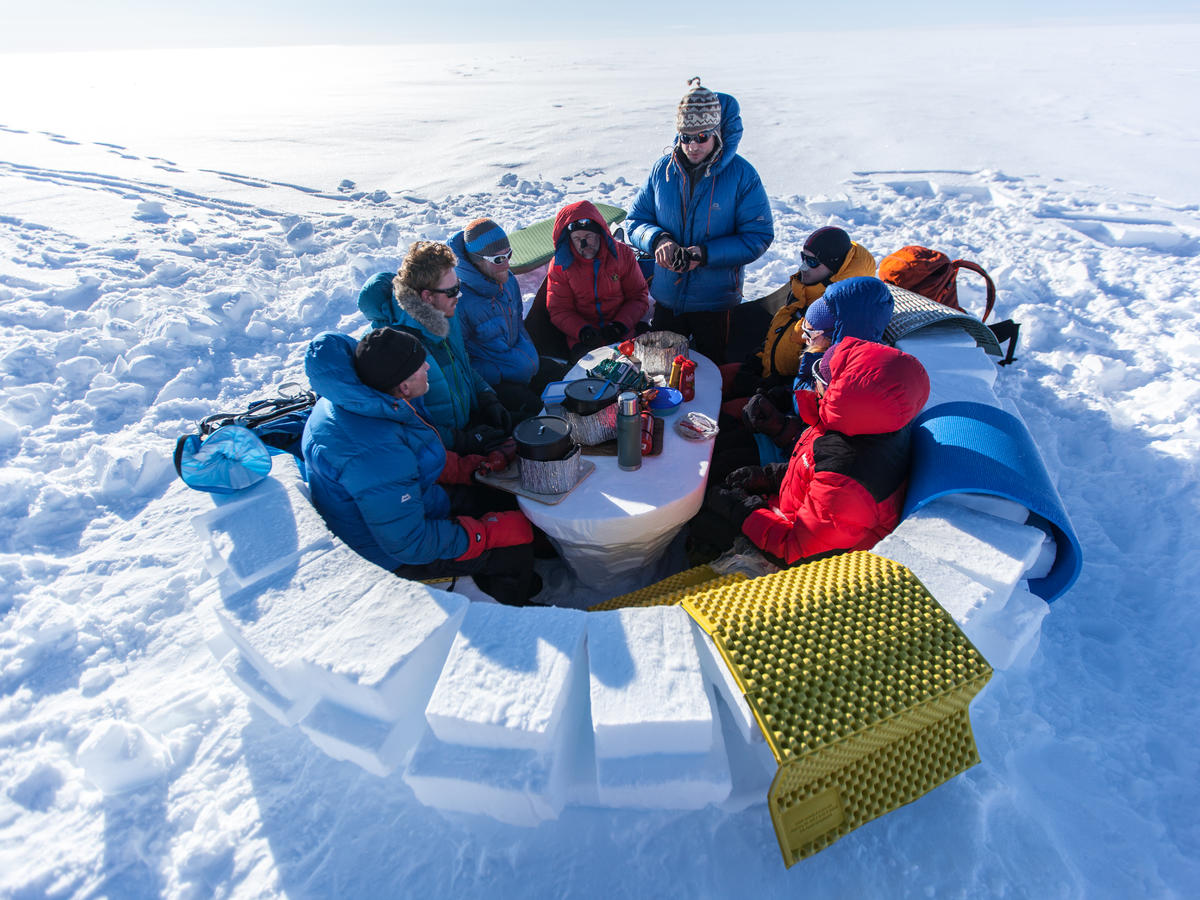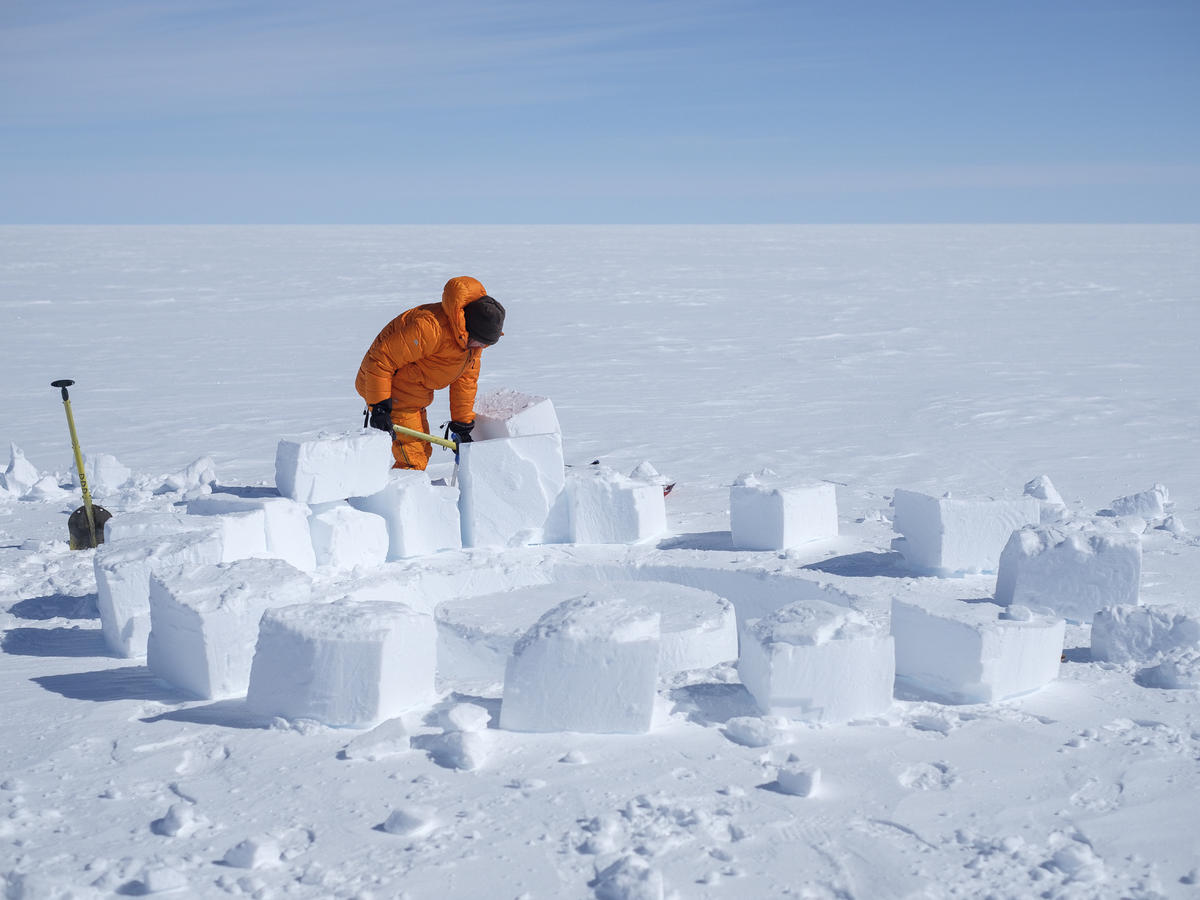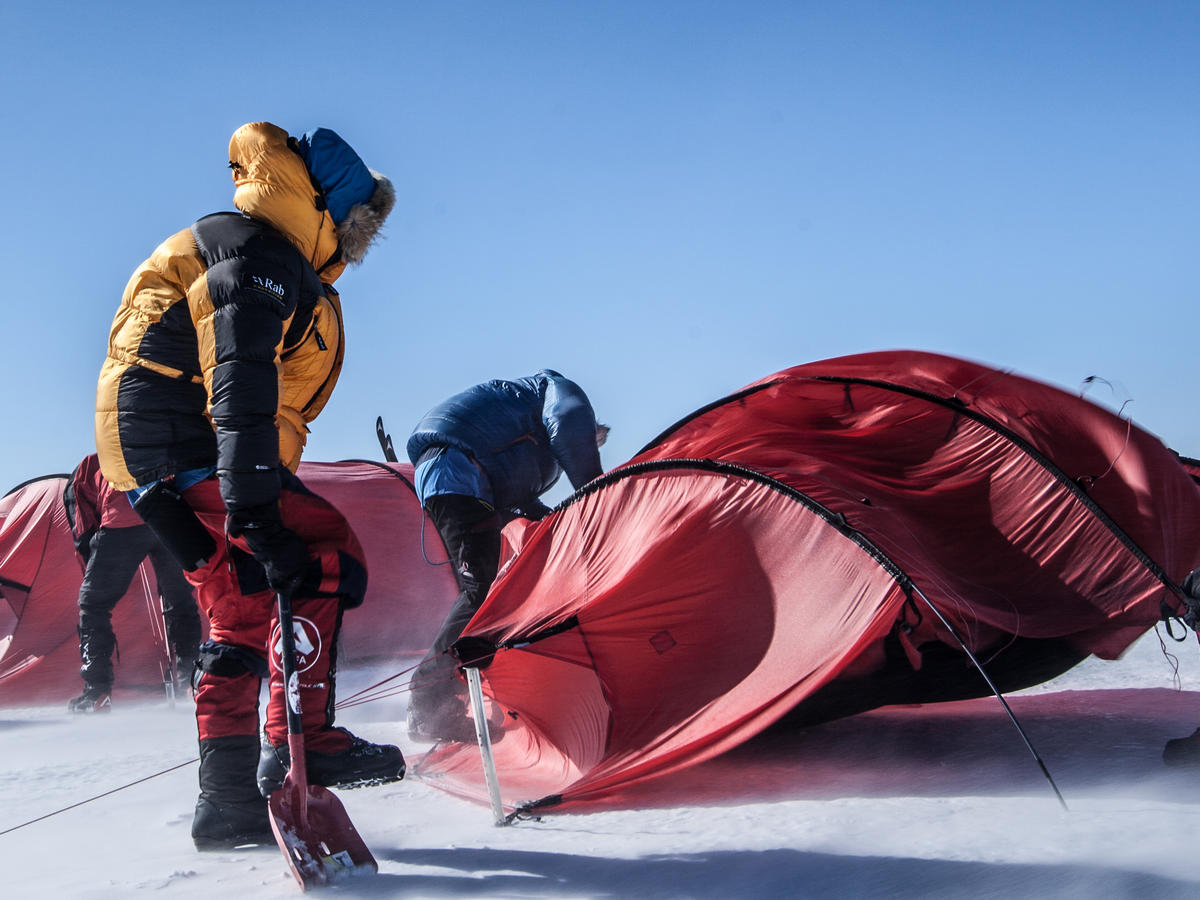Only a few times is it so critical to know the answer to the question "what should I wear?" like when you go on a winter trip. There is no one-size-fits-all solution, but here is some good advice on what you should pack when going on a long trip in the winter months.
The equipment list is often long when it comes to clothing and equipment for winter trips, and it is somewhat annoying that it hardly matters how long the trip is. You often end up having just as much with you for the short trip as for the long one. Either way you must be prepared that the weather can change quickly.
Clothing for winter trips
Multi day winter trips with skis gives you the freedom to move around with everything you need in a backpack or a sled. If you are going on a trip in remote areas, you must test and know your equipment well before you stand on the starting line. What you need for a skiing expedition is not a question that has two lines under the answer, here personal preferences play a big role, this information is therefore not a conclusion, but a guide based on the experiences we have after taking partisipants on skiing expeditions to places such as Greenland, the Northwest Passage and Svalbard for more than 30 years. However, the gear that is used for ski expeditions with sled and tent is mostly the same as that used for other nordic back country skiing trips, wheter you ski from cabin to cabin or carrying a backpack instead of pulling a sled.
The first principle on any winter trip is the "layer on layer" principle, which makes it easy to adjust clothing according to temperature and effort. Apply several thinner layers rather than a few thick ones.
Wool is gold
On the inner side of the body, you should wear wool on a long ski trip, and this also applies to the underwear. Cotton and most synthetic underwear don't keep you warm when they're wet with sweat, plus they're not self-cleaning like wool, so they'll start to smell after a short time. You should have wool panties/boxers, for women the sports bra should also be made of wool. Thighs and buttocks are areas that are exposed to cold damage and must be kept warm. If you really can't handle wool, you can consider silk or technical synthetic underwear, but stay far away from cotton. Many people really like netting/mesh - this both breathes well, dries quickly if you sweat, and keeps stagnant, insulating air well. Mesh is fine both on top and bottom. Available in both wool and synthetic, possibly a mixture, as well as having options for different levels of warmth. If it is cold, you can supplement with an extra layer of wool over the mesh so that you get two layers. If you don't like or have mesh, it also works fine to use regular wool in two layers. Everyone copes with the cold differently and some need more clothing than others, but it is important to remember that you get warm quickly from pulling a heavy sled. Dress so that you are a little cold right when you start, you will quickly warm up and it will waste a lot of time to adjust your clothes if you have to do it after every break. Keep the down jacket ready so it is easily accessible and use it to keep you warm when there are breaks. You should always put on a jacket when you stop, even just for 5 minutes. Two sets of wool will last no matter how long the trip.
Between everything
On the coldest days, you must have an intermediate layer over wool, this garment is also often used inside the tent, where the temperature is comfortable as long as the burner is in use. A thick fleece or a thick wool sweater does the trick. A fleece jacket is lighter and easier to put on and take off than the woolen jumper that you have to pull over your head, but the woolen jumper keeps you warm even if you get a little wet or sweaty.
Shell is awesome
Over wool, it is time for a water- and wind-protective layer. A tightly woven cotton anorak will breathe better than most shell clothing on the market, and provides good wind protection. Unfortunately, the cotton anorak is not waterproof and most models will be heavier than shell jackets. Therefore, we recommend that you use a three-layer shell jacket. This means a high quality wind- and waterproof shell. Skiing expeditions wear and tear on the equipment, so it is important that you do not choose the lightest and thinnest model. Make it durable. The jacket must have a hood that protrudes slightly in front of the face so that it protects well from the wind. If it is not possible to attach a fur collar, you can sew or glue on a velcro fastener for this purpose. A fur collar made of either real or artificial fur is not something you must have, but it does take some of the wind and blowing snow away, thus making it a little cozier inside the hood and around the face. The jacket should have ventilation under the arms and velcro tightening around the wrists, it should zip all the way up to the chin and be roomy enough to have space for a thick fleece or wool sweater underneath. Many people (specifically women) like to have the jacket extra long so that it protects the hips and buttocks from the weather and wind, but this is often a matter of taste. Whether you like jackets with spacious pockets to have room for sun protection, the daily ration of snacks, gps, compass etc. is also a matter of taste. The most important thing is that you create a routine where you store all loose items that you use often so that you can be efficient during breaks. For example, put the toilet paper at the top and in the same place every time, so you don't spend the whole break trying to end the sled after the paper when it's urgent. This packing strategy will help you be organized and efficient for the duration of the trip, and may take a day or two to properly adjust to your systems.
The shell trousers you use should also be of a durable variety. To avoid slips in the lining between the jacket and trousers, it is a good idea to go for bibs. They should have zips for ventilation in the sides and there is absolutely great to have a drop-seat solution that makes it possible to use the bathroom without taking off your trousers. Some models on the market have pockets adapted to pieces of sleeping mat by the knees, which comes in handy when you have to set up the tent and often find yourself sitting on your knees for a while. If the supplier hasn't thought of it for you, it's a good idea to tie an extra piece of rope to the zipper loops so that you can easily adjust the zippers even with big mittens (when you first start doing this, do the same with the zippers on the tent you will use).
Down jacket disco
A down jacket is your temple and your sanctuary on the trip. Your safe and warm haven that is always ready to throw at you during all breaks, and as soon as it's time to set up camp. It must have a hood and be thick, preferably one that reaches a little down to your thighs. The jacket should be large enough that you can easily close it over all your layers. Choose a variant that is constructed with a down chamber and not sewn through as the latter will let the cold and wind through. A good down jacket quickly costs several thousand kroner, but it is a good investment that will last for many years. You will be miserable without it, and can be dangerously cold. Many excellent jackets can be found second hand at a cheaper price. Most well-known brands use down of good quality and which is sustainably traceable. This takes into account that the birds from which the down comes have had a good life and that their feathers have not been plucked from while they were alive. Make sure you buy a jacket that has enough down and is warm enough for the trip you are going on.
Ski boots
When it comes to choosing shoes for the ski trip, personal preference plays a big role. There is a difference in how easy it is for your feet to freeze or not, whether you your legs and feet sweat and simply how your feet are built. Always buy what is most comfrotable for your individual foot. Of course, it also plays a big role where you are going on a ski trip and how long you will be away. On a spring ski trip from Finse to Hardanger, it may not be necessary to use the most expensive and warmest variant, but if you are going to cross Svalbard from South to North and exposing yourself to temperatures down to -40, it is important that you have a shoe that can keep your legs and feet warm. There are many models you can choose from and the first decision relates to the choice of binding on the skis. On all our longer ski trips (such as Svalbard lenghtwise) we require you to use BC Maunell or Magnum binding, and your shoe must therefore fit this type of binding. You then have to decide whether you should choose a shoe with an integrated gaiter, or whether you want a more flexible solution where you use a loose gaiter on the outside of the shoe that can come off and on as your please. If you choose a shoe with an integrated gaiter, there is less to keep track of, it is a solution that is quicker to take off and on during the trip. You can choose whether you want a shoe with an insulated gaiter (such as Alfa Polar A/P/S BC) or a thinner version (such as Alfa Outback A/P/S BC). If, on the other hand, you choose a shoe without an integrated gaiter, such as Crispi Stetind BC, you have more flexibility in using the shoe, for cold walks you can throw on a Berghaus Yeti gaiter or a variant in neoprene for extra warmth. On less cold/shorter trips/from cabin to cabin - you can put on a classic gaiter instead to keep the snow away. Regardless of what gaiter solution you go for, it is important to choose a roomy boot so that you have space for sufficient heat-insulating layers inside.
Inside of the ski boots
As with everything else on the body, cotton is also prohibited when it comes to socks. Wool or wool blends are preferred against the skin. A thin wool lining on the inside, then a vapor barrier before a thicker sock.
For extra insulation it is even possible to use a blend stiff wool slipper "ullkartank", or a "intuition" polar liner (only for Alfa Polar A/P/S) inside the ski boot (needs extra room). Some people drop the extra thick sock and run the vapor barrier straight into the wool slipper, others drop the wool slipper and run an extra wool sock instead.
In terms of price, it is more reasonable to choose only wool socks or a wool slipper over an intuition liner, but the duration of the trip and where you are going matters. The wear resistance is better on an intuition liner than on the wool piece - it will last longer. However, the wool piece it is well-proven and provides a softness in the build-up of the contents of the boot which may contribute to less risk of chafing and blistors. Again, it is taste and comfort that decide, and price. If youre unsure, you can only guess what will work for you and try it out on trips before your tour begins.
The vapor barrier keeps the sweat and moist away from the thick wool sock and ski boot, and as it prevents these getting wet, the good insulation will be kept, and you woun't need to dry the sock or boots along the way. Some say wapor barriers also help preventing blistors. Just remember to take them off when you arrive in camp after skiing the whole day, let your feet breathe for a minute, dry them, and put on some dry socks for the evening and night. Air the moist inner socks and the wapor barriers, and wear them again the next morning. Instead of an icy and frozen boot that you first have to thaw with your own body heat in the morning, you have dry boots as you go. Vapor barriers are something we recommend. Here you can either buy ready-made versions at the sports shop that are more or less shaped to fit the foot, or you can use plastic bags. The ready-made versions obviously last longer and are perhaps better for the environment than using plastic bags that break. Bring a few extra if you are going on a long trip.
Finally, take care of your feet along the way. Invest in new socks that haven't lost their shape or are about to get holes in them. Change the inner sock maybe once a week and always have a pair of tent socks in your sleeping bag that you can use in camp in the evenings. Dry your feet every day when you take off your ski boots, an if you want to be extra kind to your feet (especially on the longer expeditions), give them a light massage, clean in between your toes each night and dust them with a layer of talcum powder before putting them in dry socks. If you are prone to chafing, it may be worthwhile to apply sports tape as a preventive measure (possibly Tensoplast or chafing plaster).
In camp, it is nice to have a pair of tent booties with which you can move around inside the tent and for short trips outside. Make sure they are easily packable, lightweight, insulated and has a protective semi durable material on the outside to protect the insulation from the snow. Such as Exped Camp Booty. Down, wool or primaloft? Up to you!
Warm hands
Mittens are warmer than gloves, gloves are easier to work with than mittens. It's a bad idea to work with bare fingers when you're on a skiing expedition. Whatever you are going to do, you need to be able to carry out the task with gloves on rather than take them off and risk freezing your fingers. Its difficult to get them warm again, and you can quickly get a cold injury. Mittens and gloves are prone to blowing away, please always stash them in your jacket or pockets when not using them, and bring an extra pair. Never just leave them on the ground. You need a pair of insulated gloves, a pair of felted wool mittens and wind mittens (such as Norrøna Trollveggen Gore-Tex Pro Mittens) to pull outside as basic equipment. In addition, it is nice to have a pair of thinner wool gloves/liners to work with when you have to handle the burner, set up the tent and similar tasks where you depend on a good grip. There are many different woolen liners that can be used for this purpose, but the disadvantage is that they are often expensive and easily puncture. The alternative could be a thin leather glove with a wool lining, these will withstand more and also give you a better grip. If you think this is going to be expensive, it might be just as well to visit H&M to stock up on a small stock of affordable "knitted gloves", they will wear out faster, but do the job just as well as more expensive versions in the sports shop.
If you know that you struggle with your fingers getting cold quickly, it is worth the investment to bring a pair of warm down mittens that you can have on the coldest days.
If you're quick to put down your mittens everywhere, you can attach an elastic to a string to the mittens, thread the elastic around your wrist before you put the mittens on and avoid losing them the next time you take them off. This is a solution that also comes ready-made from a number of suppliers.
Keep your head warm
If you are on a long trip, you will experience different weather and temperatures, feel free to bring both a thick and a thin hat so that you can vary accordingly with the weather. If you think it might get a little claustrophobic with a hood on, maybe a windproof hat is the solution for you, and you can peak your head out. If you're going on a trip in the spring, it's nice to bring a headband that protects your ears from the wind and use over your eyes when sleeping.
Don't bluff with buff
You will probably want to wear this piece of clothing for the entire trip. Sometimes two at the same time. Can be used as a neckerchief, hat, headband, face mask and potholder. Bring two and at least one of them should be thicker wool. Trips on Svalbard also requires a proper face mask, for example neoprene. Just make sure it has ventilation around the mouth/nose area.
Ski goggles
Alpine ski goggles is a must on any ski expedition or nordic back country ski trip. When it is windy and snowy, ski goggles are indispensable. Yellow/orange or pink glass make it easier to see contrasts. If you are handy, you can sew on a piece of neoprene on the underside of the glasses and get extra wind protection for the nose and cheeks.
Nice to have
Down/primaloft shorts, trousers or skirt - thighs and buttocks are particularly susceptible to cold damage. On cold days, during breaks and in the tent, an extra insulating layer is good to have. Such as Norrøna Lyngen Down850 Knickers or Falketind Thermo40 Shorts. We recommend skirt or shorts/knickers on most ski trips, trousers on the longest and coldest trips (as crossing Svalbard lenghtwise).
A light windbreaker takes up little space if you are skiing with a sled, and is a garment you will love to take out on the hottest days to escape the shell jacket, which breathes poorly and quickly becomes too warm to wear. The windbreaker can also be used as an extra layer under the shell or the down jacket and provides extra thermal insulation.
Down/primaloft vest - you either like vests or you don't. If you like them, go with a vest - it gives you good flexibility in what you wear and keeps your core warm. The vest can be combined with a shell jacket when there are extra cold days or at the end of the day when the sun is a little lower and the temperature drops.
Skis & bindings
Nordic back country touring skis - durable skis, preferably with steel edges, without also works (for people skiing with their dog this is preferred). Most commonly these kinds of skis should be 10-20 cm (3.9-7.8 inches) longer than your own body height, dependent on type and skier weight. Midsole width around 50-66 mm (1.9-2.6 inches). The skis may be for wax or wax free/crown - either way we recommend skis with integrated attachment for short skins. Examples of skis can be the ultra classic Fischer Transnordic 66 (Easy Skin Extralite or Crown), the popular Norwegian Åsnes Nansen or Cecilie Skog (BC or Waxless), or the underdog Madshus Panorama T55 Intelligrip® Transition.
For bindings we recommend Rottefella BC Manuell or Magnum (both operated manualy). On our longest and most remote ski expeditions we require these. However, on most trips it is also possible to use the classic 75 mm system, or the new Rottefella Xplore. The most important is that your boots and bindings fit together, this must be checked before the trip starts. Cross-country bindings are not possible to use.
Skins
Depends on the snow conditions and terrain, but normally we use long skins for trips in hilly terrain and/or trips where it is a great possibillity for a lot of snow - espesically when touring with a heavy sled big snow falls can require long skins. Short skins is strongly recommended on all nordic ski trips. They make skiing more pleasent in wet or other conditions where wax is difficult to use. Some skis have integrated attachment holes for short skins, make sure you get the right ones for your skis. Width - narrow for better glide, wide for better grip. Skin matereal - most common types are mohair, nylon or a mix. Mohair is better for colder conditions and they glide better. The drawback is that they are the most expensive, and that they have a shorter life span, as they wear out faster. Nylon last longer, they are cheaper, have a superb grip, and more ideal for warmer conditions. The minus is the glide - wich is notacebly poorer than the mohair ones. At last, an option might be to buy the mix ones, and get a little bit of everything.
Poles
Normally +/- 5 cm/1.9 inches shorter than classic style cross country poles. Aluminium or carbon is fine, but the lightest carbon poles is less durable and might break during transport or skiing. A "long" and soft handle makes the poles flexible in use and is very comfortable. Telescopic poles is ok most trips, but make sure they have a durable locking mechanism - not the twisting type. Most important it the basket - this need to be a big powder basket (about 10 cm/3.9 inches in diameter). The baskets should also be flexible, as they alow the pole tips to give a better grip in the snow this way. Example: the classic Swix Mountain Tourer, the lighter Mountain Extreme, or the telescopic Leki Haute Route XT.
Have a good trip!
